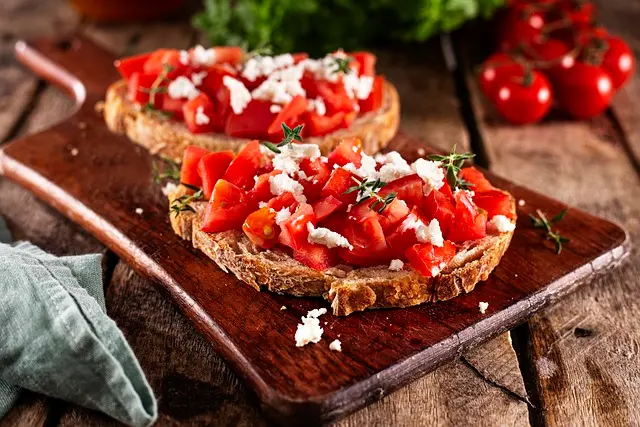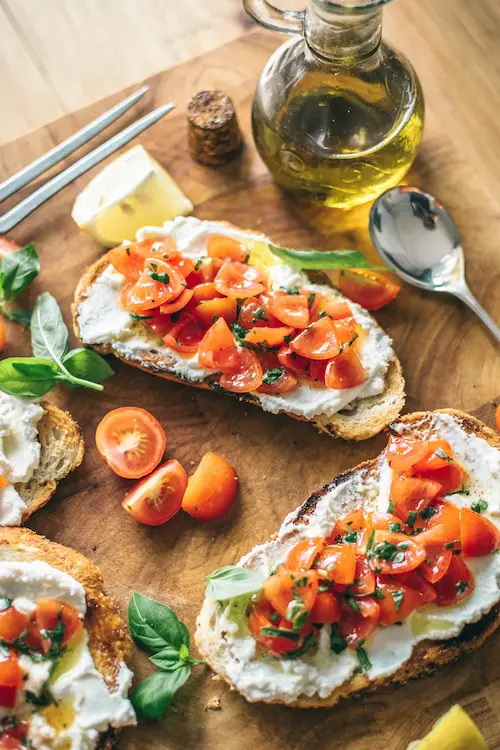The Ultimate Appetizer
Balsamic Bruschetta, Where Fresh Meets Flavor!
My first time trying balsamic bruschetta was in a cozy tapas place in Edmonton Alberta with my great
uncle, he loves bruschetta and was so excited to share it with me. At the first bite, I soon
realized he was right it is a wonderful appetizer. Mainly because it features a bunch of fresh and
flavourful ingredients. The dish starts with toasted ciabatta bread or baguette as the base. It is
then topped with some tasty tomatoes, basil, garlic, and a drizzle of olive oil. Now if you're a
cheese lover like me you can add some mozza or parmesan. Although the best and final ingredient has
to be the balsamic vinegar with its slightly sweet flavour, it adds the perfect balance of tanginess
and richness completely elevating the appetizer to a new level. With that, you’ve crafted a balsamic
bruschetta that’s sure to please.
Balsamic Vinegar or Balsamic Glaze?
The main difference between balsamic vinegar and balsamic glaze is their consistency, flavour
and overall usage. Balsamic vinegar relies on the traditional aging method, allowing time
and nature to weave their magic giving it a more tart and acidic but yet sweet flavour.
Balsamic glaze is thicker and syrupy, and when being made it takes a shortcut by infusing
additional flavours and rapidly reducing the liquid to create a more concentrated product,
giving it a sweeter and less acidic flavour. Either of these are great toppings to add to
your bruschetta to give some extra zest.
Balsamic Vinegar Alternatives
If you're looking for alternatives to balsamic vinegar in bruschetta, there are plenty of
wonderful substitutes that can still achieve a similar taste to the classic balsamic
bruschetta. Here are a few substitutes that can still provide a delicious flavour, red wine
vinegar, lemon juice, white wine vinegar, pomegranate molasses, sherry vinegar and apple
cider vinegar. Each option will bring a slightly different twist to the bruschetta, but they
all provide a nice balance of acidity.
Common Questions About Bruschetta
Bruschetta or bruschette?
The difference between bruschetta and bruschette is in language and usage. Bruschetta (singular)
refers to a single slice of toasted bread often coated with garlic and drizzled with olive oil.
Sometimes topped with ingredients like tomatoes, basil, or cheese. Bruschette (plural) refers to
more than one slice of bruschetta. In Italian when referring to multiple pieces of bruschetta the
word changes to "bruschette." So, if you order one slice you'd call it bruschetta but if you're
serving or ordering several you'd say bruschette. The best bread to use for bruschetta should have a
sturdy crust and a firm texture to support the toppings of the appetizer. For a classic bruschetta,
opt for Italian bread like ciabatta. What makes Ciabatta different from other breads is that it is
baked with a much higher hydration level, making the holes within the dough much bigger. However,
any type of bread can be substituted as long as it's plain.
Difference Between Bruschetta and Caprese?
Bruschetta and caprese are both popular and classic Italian appetizers with very distinct
differences, these differences are in preparation and presentation. Bruschetta is a toast-based
appetizer and Caprese is more of a plated salad with no bread involved, highlighting the freshness
of its ingredients without any cooking. To further explain, Bruschetta is always made with grilled
or toasted bread, typically rubbed with garlic and drizzled with olive oil or balsamic vinegar. Then
it is topped with ingredients like diced tomatoes, basil and garlic. It’s served as individual
slices that can be eaten as finger food. Where as Caprese, on the other hand is a fresh salad made
with slices of mozzarella cheese, tomatoes and basil leaves, usually arranged on a plate and
drizzled with olive oil or balsamic vinegar.
Difference Between Bruschetta and Crostini?
Bruschetta and Crostini are again both Italian appetizers featuring toasted or grilled bread but they
do vary in bread type and size along with preparation. Bruschetta is typically made with larger more
rustic and thicker bread like sourdough which is then grilled and traditionally rubbed with garlic
before being drizzled with olive oil. It’s often topped with diced tomatoes, basil, and garlic but
can include other toppings like meats or vegetables, making it a hearty, finger-friendly dish. Where
as Crostini on the other hand is made with smaller thinly-sliced baguette bread that’s simply
toasted and drizzled with olive oil without garlic. Crostini toppings are usually more delicate such
as pâtés, cheeses, or spreads. Creating a refined bite-sized hors d'oeuvre.




